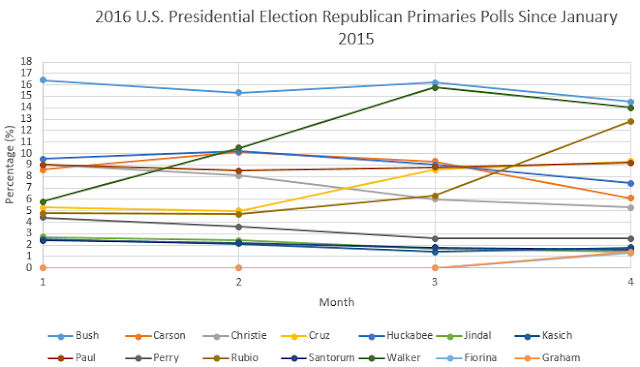The U.S. presidential polling averages have been updated for the month of April. Five polls have been released this month for the Republicans. Two of them have Jeb Bush in the lead, two put Marco Rubio up front, and one poll has Scott Walker leading. Only one Democratic poll has been released with Elizabeth Warren. Many polling firms are no longer including her, so if further polls do not include the Massachusetts senator, then I will have to update the numbers for the Democrats and remove Warren. The one poll I included for the Democrats has Hillary Clinton with a comfortable lead with Warren in second and Joe Biden in third.
Republican Nomination
Changes in position (rank) and percentage points are indicated by green for an increase, red
for a decrease, and nothing if the candidate's position remains
unchanged. Note that these are changes since the March update, not the most recent polling average.
1. Jeb Bush: 14.5% (-1.7 pp)
2. Scott Walker: 14% (-1.8 pp)
3. Marco Rubio: 12.8% (+4, +6.5 pp)
4. Ted Cruz: 9.3% (+2, +0.7 pp)
5. Rand Paul: 9.2% (+0.4 pp)
6. Mike Huckabee: 7.4% (-2, -1.6 pp)
7. Ben Carson: 6.1% (-4, -3.2 pp)
8. Chris Christie: 5.3% (-0.7 pp)
9. Rick Perry: 2.6%
10. John Kasich: 1.8% (+2, +0.4 pp)
11. Rick Santorum: 1.6% (-1, -0.2 pp)
12. Bobby Jindal: 1.4% (-1, -0.3 pp)
13. Lindsey Graham: 1.4%
14. Carly Fiorina: 1.3%
Note: Carly Fiorina and Lindsey Graham have been added to the list.
Below is a graph showing the candidates' polling averages after each
month in 2015. Note that month 1 means January, 2 means February, and so
on.
Bush: Bush's numbers went down this month as his friend and fellow Florida politician, Marco Rubio, declared candidacy. He is still in the lead, but is only half a percentage point above Walker. The polls have given Bush a variety of percentages. NBC/The Wall Street Journal gave him 23%, while The Economist and Fox News put him at only 9%, in third place.
Walker: The Wisconsin governor's polling average has gone down for the first time after a rapid increase from January to March. However, he is close behind Jeb Bush. For a brief time in mid-April (one polling average update), Walker was just ahead of Bush.
Rubio: Rubio's polling average more than doubled after he announced that he would seek the Republican nomination for president. With nearly 13%, Rubio can now be considered a front-runner.
Cruz: The Texas senator has gone up this month and is in fourth place, still a contender for the Republican nomination. He was in third in a previous polling update.
Paul: Rand Paul also experienced a polling bump after announcing candidacy. He has maintained this fifth place position and has been polling quite consistently.
Huckabee: The 2008 Republican primary contender has dropped two places. However, the polling average here does not include polls that were taken after he announced that he would run for president.
Carson: Dr. Ben Carson has had the biggest fall this month. He was in third place in March with 9.3%, but he is now at only 6.1% and in seventh. Carson also said that he will run for president, but March polls do not reflect this as they were taken beforehand.
Christie: Christie is still continuing in a downward trend.
Perry: The former Texas governor's polling average has not changed since March.
Kasich: The Ohio governor's average increased very slightly, but enough to place him ahead of Santorum and Jindal.
Santorum: The 2012 Republican primary runner-up has polled no higher than 3% this month.
Jindal: Jindal is in 12th place with poor polling results.
Graham: The senior senator from South Carolina has been added to the list. He is currently polling at 1.4%, less than a percentage point behind Bobby Jindal.
Fiorina: A former business executive, Fiorina is currently polling at 1.3%. She is the only major female Republican candidate and is also one of the wealthiest candidates running.
The Republicans appear to have separated into three main tiers: the front-runners (Bush, Walker, and Rubio), the challengers (Cruz to Christie), and the long-shots (Perry to Fiorina). All these levels are based solely on polls. Larry J. Sabato, from the University of Virginia, has made a great classification of the Republican and Democratic candidates and has categorized them. His tiers are based not only on polls, but also political experience, money, and support. I recommend that you check it out and subscribe to his email newsletters.
Democratic Nomination
Changes in position (rank) and percentage points are indicated by green for an increase, red
for a decrease, and nothing if the candidate's position remains
unchanged. Note that these are changes since the March update, not the most recent polling average.
1. Hillary Clinton: 59.9% (-0.3 pp)
2. Elizabeth Warren: 12.1% (+1, +0.4 pp)
3. Joe Biden: 11.4% (-1, -1.8 pp)
4. Bernie Sanders: 4.2% (+0.3 pp)
5. Martin O'Malley: 1.3% (+1)
6. Jim Webb: 1.1% (-1, -0.2 pp)
Below is a graph showing the candidates' polling averages after each month in 2015. Note that month 1 means January, 2 means February, and so on.
Clinton: The former First Lady and Secretary of State is still well ahead of the pack.
Warren: Warren has overtaken Joe Biden, but is still miles behind Hillary Clinton.
Biden: The vice-president is now behind Warren and is in third place.
Sanders: The independent senator from Vermont (he caucuses with the Democrats) has been polling consistently. He announced that he would run for president on April 30. This is not reflected in this month's poll.
O'Malley: Martin O'Malley is still in front of Jim Webb, but the recent Baltimore riots may cause him some trouble in future polls.
Webb: The Virginia senator is polling at 1.1% and is in sixth.
The Democratic primary is much less competitive than the GOP field and some believe that it will be more of a coronation than a contest.




